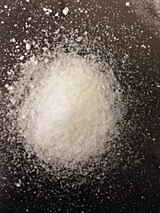Sodium perrhenate

| |

| |
| Names | |
|---|---|
| Other names
Sodium rhenate(VII)
| |
| Identifiers | |
3D model (
JSmol ) |
|
| ChEMBL | |
ECHA InfoCard
|
100.033.388 |
PubChem CID
|
|
RTECS number
|
|
| UNII | |
CompTox Dashboard (EPA)
|
|
| |
| |
| Properties | |
| NaReO4 | |
| Molar mass | 273.1866 g/mol |
| Appearance | white solid |
| Density | 5.39 g/cm3 |
| Melting point | 414 °C (777 °F; 687 K) |
| 103.3 g/100 mL (0 °C) 114.0 g/100 mL (25 °C)[1] 145.3 g/100 mL (30 °C) 173.0 g/100 mL (50 °C) | |
| Solubility | soluble in water (> 1130 g/L at 25 °C)[1] |
| Structure | |
| tetragonal | |
| Hazards | |
| Occupational safety and health (OHS/OSH): | |
Main hazards
|
Oxidizer, skin/eyes irritation |
Except where otherwise noted, data are given for materials in their standard state (at 25 °C [77 °F], 100 kPa).
| |
Sodium perrhenate (also known as sodium rhenate(VII)) is the inorganic compound with the formula NaReO4. It is a white salt that is soluble in water. It is a common precursor to other rhenium compounds. Its structure resembles that of sodium perchlorate and sodium permanganate.
Preparation
It can be prepared by treatment of
rhenium heptoxide with base or by ion exchange from the potassium salt.[2]
Sodium perrhenate can be prepared from rhenium metal with hydrogen peroxide in the presence of base.[3]
Reactions
It reacts with sodium in ethanol to give
nonahydridorhenate.[2]
Sodium perrhenate has been used as a precursor of rhenium nitrides (such as Re3N, Re2N, Re3N2, ReN2, ReN3, ReN4), which can be used as catalysts for ammonia synthesis and for hydro-denitrogenation.[4]
It can be used to prepare Re2(CO)10.[3]
References
- ^ .
- ^ ISBN 978-0-470-13244-9.
- ^ .
- S2CID 51721705.
Further reading
- Ahluwalia, J. C.; Cobble, J. W. (1 December 1964). "The Thermodynamic Properties of High Temperature Aqueous Solutions. II. Standard Partial Molal Heat Capacities of Sodium Perrhenate and Perrhenic Acid from 0 to 100o". Journal of the American Chemical Society. 86 (24): 5377–5381. .
- Dwek, Raymond A.; Luz, Z.; Shporer, M. (1 May 1970). "Nuclear magnetic resonance of aqueous solutions of sodium perrhenate". The Journal of Physical Chemistry. 74 (10): 2232–2233. .

